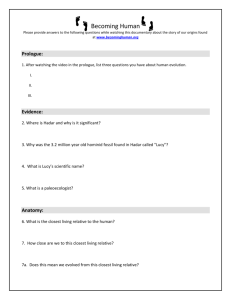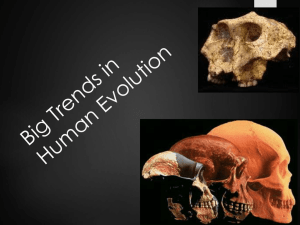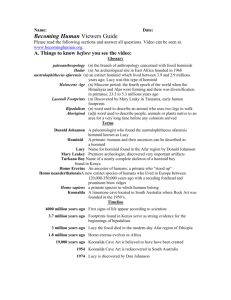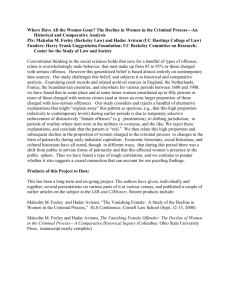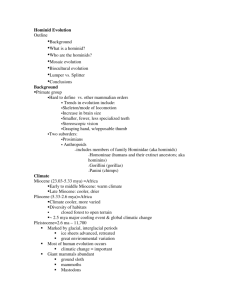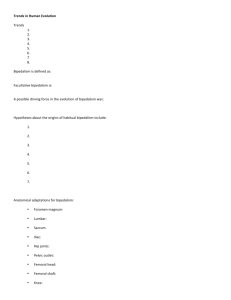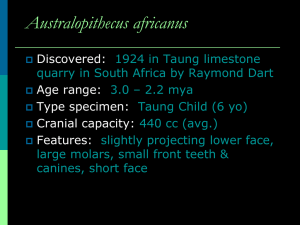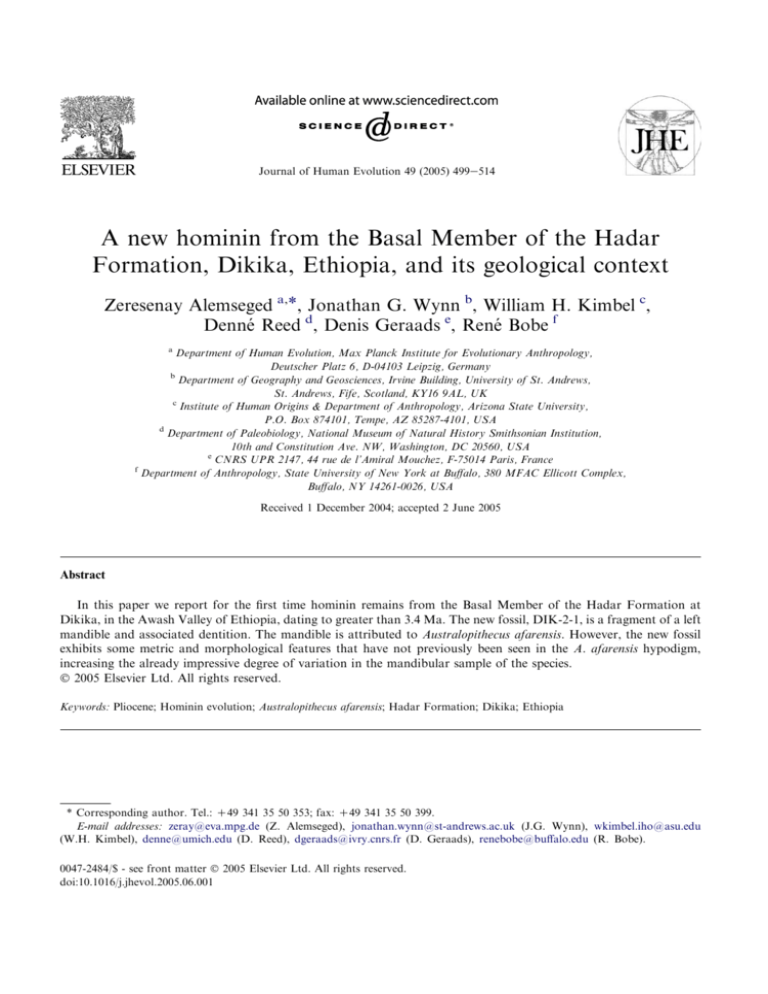
Journal of Human Evolution 49 (2005) 499e514
A new hominin from the Basal Member of the Hadar
Formation, Dikika, Ethiopia, and its geological context
Zeresenay Alemseged a,*, Jonathan G. Wynn b, William H. Kimbel c,
Denné Reed d, Denis Geraads e, René Bobe f
a
Department of Human Evolution, Max Planck Institute for Evolutionary Anthropology,
Deutscher Platz 6, D-04103 Leipzig, Germany
b
Department of Geography and Geosciences, Irvine Building, University of St. Andrews,
St. Andrews, Fife, Scotland, KY16 9AL, UK
c
Institute of Human Origins & Department of Anthropology, Arizona State University,
P.O. Box 874101, Tempe, AZ 85287-4101, USA
d
Department of Paleobiology, National Museum of Natural History Smithsonian Institution,
10th and Constitution Ave. NW, Washington, DC 20560, USA
e
CNRS UPR 2147, 44 rue de l’Amiral Mouchez, F-75014 Paris, France
f
Department of Anthropology, State University of New York at Buffalo, 380 MFAC Ellicott Complex,
Buffalo, NY 14261-0026, USA
Received 1 December 2004; accepted 2 June 2005
Abstract
In this paper we report for the first time hominin remains from the Basal Member of the Hadar Formation at
Dikika, in the Awash Valley of Ethiopia, dating to greater than 3.4 Ma. The new fossil, DIK-2-1, is a fragment of a left
mandible and associated dentition. The mandible is attributed to Australopithecus afarensis. However, the new fossil
exhibits some metric and morphological features that have not previously been seen in the A. afarensis hypodigm,
increasing the already impressive degree of variation in the mandibular sample of the species.
Ó 2005 Elsevier Ltd. All rights reserved.
Keywords: Pliocene; Hominin evolution; Australopithecus afarensis; Hadar Formation; Dikika; Ethiopia
* Corresponding author. Tel.: C49 341 35 50 353; fax: C49 341 35 50 399.
E-mail addresses: zeray@eva.mpg.de (Z. Alemseged), jonathan.wynn@st-andrews.ac.uk (J.G. Wynn), wkimbel.iho@asu.edu
(W.H. Kimbel), denne@umich.edu (D. Reed), dgeraads@ivry.cnrs.fr (D. Geraads), renebobe@buffalo.edu (R. Bobe).
0047-2484/$ - see front matter Ó 2005 Elsevier Ltd. All rights reserved.
doi:10.1016/j.jhevol.2005.06.001
500
Z. Alemseged et al. / Journal of Human Evolution 49 (2005) 499e514
Introduction
The Hadar Formation of Ethiopia is well known
for its contributions to our knowledge of the
species Australopithecus afarensis (e.g., Johanson
et al., 1978, 1982; Kimbel et al., 1994, 2004). The
vast majority of the species’ hypodigm, including
the partial skeleton known as ‘‘Lucy,’’ comes from
Hadar Formation sediments exposed at the Hadar
site, which is located near the village of Eloaha in
the Awash River valley. In addition to Hadar,
remains of A. afarensis have been recovered from 1)
the Laetolil Beds in Tanzania (where the type specimen, LH-4, was found); 2) undesignated strata
near Fejej1 in southwestern Ethiopia (Asfaw et al.,
1991; Kappelman et al., 1996); 3) the Tulu Bor
Member of the Koobi Fora Formation, east of
Lake Turkana, Kenya (Kimbel and White, 1988);
4) the Nachukui Formation, west of Lake Turkana,
Kenya (Brown et al., 2001); and 5) informally
designated ‘‘formations x and w’’ of the Middle
Awash valley of Ethiopia (White et al., 2000).
The aggregate time span of the species is at least
0.7 myr, from ca. 3.7 to 3.0 Ma (Kimbel et al., 2004).
Large hominin sample size and stratigraphic
continuity at Hadar have enabled researchers to
assess the contribution of sexual dimorphism
(Kimbel and White, 1988; Kimbel et al., 1994,
2004) and temporal trends (Lockwood et al., 2000)
to total morphological and metric variation in A.
afarensis. However, data about A. afarensis and
other early hominins are meager during the
interval between the Hadar and Laetoli parts of
the hypodigm, and fossil evidence from older sites,
such as Allia Bay and Kanapoi (3.9e4.1 Ma) that
contain the remains of A. anamensis, the probable
ancestor of A. afarensis (Leakey et al., 1995, 1998).
While samples from Hadar and Laetoli are both
attributed to A. afarensis, the morphological
variation within the hypodigm is such that the
older Laetoli sample is, in comparable parts of the
anatomy, closer morphologically to A. anamensis
than the younger Hadar assemblage of A. afarensis
(Leakey et al., 1995; Lockwood et al., 2000;
1
As the evidence from Fejej is very fragmentary, more fossils
from the site are required to confirm the taxonomic status of
what has already been found.
Kimbel et al., 2004). Additional fossil evidence
from between ca. 3.9 and 3.4 Ma is thus critically
important, as it could shed light on the nature of
the differences between the Hadar and Laetoli
samples and the hypothesized phyletic relationship
between A. afarensis and A. anamensis. Moreover,
increasing the fossil sample from sediments older
than 3.4 Ma will help test hypotheses about lineage
diversity during the middle Pliocene (Brunet et al.,
1996; Leakey et al., 2001).
The Basal Member of the Hadar Formation,
which includes strata below the Sidi Hakoma Tuff
(SHT; older than 3.4 Ma [Walter and Aronson,
1993]), is well exposed on the southeastern side of
the Awash River adjacent to the Hadar and Gona
research areas (Fig. 1). Due to the slight dip of the
sediments and regional faulting, the Basal Member
is exposed in only small patches on the north
banks of the Awash at Hadar. Positioned at
approximately 11 10# N 40 60# E, Dikika is
south of, and across the Awash River from, the
main Hadar research area (Fig. 1). Part of the
Dikika area was mapped as part of the RVRME
(Rift Valley Research Mission in Ethiopia) during
the 1970s, and its lithostratigraphy was defined as
part of the Hadar Formation of the Awash Group
by Kalb et al. (1982). Most stratigraphic descriptions of the Hadar Formation made during the
1970s focused on the stratotype Hadar sections
north of the Awash River. Some of this early work
shows maps and sections of the Hadar Formation
in the Dikika area south of the Awash River. The
Dikika exposures were mapped as the Basal and
Sidi Hakoma Members of the Hadar Formation
(Taieb and Tiercelin, 1980; Kalb et al., 1982;
Tiercelin, 1986). Tiercelin (1986) provided several
sections of the Basal Member at Ounda Leita, of
which the thickest defines the stratotype. Stratigraphic columns of Kalb et al. (1982a) show
generalized sections of the Hadar Formation near
Gango Akidora, Andedo, and Mireh Kerone.
In 1974 and 1976, three hominin specimens subsequently attributed to A. afarensis (A.L. 400-1;
A.L. 277-1, A.L. 411-1; Johanson et al., 1982) were
collected. Not since then, however, has paleontological and geological research been conducted
on the southeastern side of the Awash River.
The Dikika Research Project (referred as DRP
Z. Alemseged et al. / Journal of Human Evolution 49 (2005) 499e514
501
Fig. 1. Geographical location of the Dikika paleoanthropological site within the horn Africa (top); locations of DIK-2 hominin
locality with in the Dikika Research Project area and major drainage patterns (bottom).
502
Z. Alemseged et al. / Journal of Human Evolution 49 (2005) 499e514
hereafter), led by the senior author, has conducted
four seasons (2000, 2002, and two in 2003) of field
work at Dikika, working under a permit from the
Authority for Research and Conservation of
Cultural Heritage (ARCCH) of the Ministry of
Youth, Sports and Culture of Ethiopia.
Twenty faunal localities have been identified at
Dikika through the 2003 field season. Fossils of
large mammals are abundant on the surface of the
deposits, and include frequent occurrences of
cranial fragments and long bones of elephants,
hippopotamus, rhinoceros, and other taxa.
In this paper, we describe DIK-2-1, a fragment
of the left side of a hominin mandible with partial
dentition of an adult individual from the Basal
Member of the Hadar Formation, and discuss
its taxonomic affinities and significance for the
evolution of early hominins. This specimen is the
first hominin recovered from the Basal Member,
the oldest of the formally recognized units of the
Hadar Formation. The specimen derives from
a stratigraphic horizon w20 m below the Sidi
Hakoma Tuff, and so its minimum age is 3.4 Ma.
Stratigraphic, sedimentary and
paleoenvironmental context of the
DIK-2 hominin fossil
The DIK-2 locality lies at the base of a small
ridge capped by a thin cross-bedded sandstone (at
6e7 meters in the section of Fig. 2) in the
headwaters of the Gango Akidora stream
(Fig. 1). The sedimentary unit producing the
fossils falls stratigraphically below a very prominent channel exposure of redeposited vitric tephra
and a co-occurring laterally extensive bentonite
that we have identified as the Sidi Hakoma Tuff by
chemical analysis of glass shards from the tuffaceous channel (Table 1). Using the date of
3.40 G 0.03 Ma for the Sidi Hakoma Tuff (Brown,
1982; Brown and Cerling, 1982; Walter and
Aronson, 1993), and extrapolating the sedimentation rate calculated from strata overlying the tuff,
we estimate an age of slightly greater than 3.4 Ma
for the hominin mandible.
The entire section in the Gango Akidora and
Ilanle areas exposes approximately 110 m of the
Basal Member through the lower Kada Hadar
Members of the Hadar Formation, and contains
a number of widespread stratigraphic markers
identified in the Hadar Formation (stratigraphic
terminology of Taieb et al., 1972). The SHT and
its associated bentonite can be traced throughout
the area, as can a series of gastropod-bearing
coquinas (SH-g) and regionally extensive ostracod-bearing clays (SH-o). The Triple Tuff-4 (TT-4)
is clearly present within this clay deposit, and is
recognized by its thin layer of feldspar crystals and
altered glass shards (Walter, 1994). The Kada
Hadar Tuff (KHT), which defines the base of the
Kada Hadar Member, and a distinctive green,
spheroidally weathering clay identified as the
Confetti Clay (CC) cap the local section above
DIK-2, occur near the top of the section.
Although there are intervals indicating stable
lacustrine sedimentation, no part of the regional
section indicates a permanent lake existing over
periods longer than a few tens of thousands of
years. Rather, pedogenic modification of deltaic
and shoreline deposits through most of the section
indicates a rapidly fluctuating ephemeral lake
within a delta or inland delta depositional system.
Three periods of relatively stable lacustrine settings are indicated by a diatomite (overlying the
SHT) and surrounding laminated clays (1e2 m
thickness in most sections), the ostracod-bearing
laminated clays in the upper Sidi Hakoma
Member (up to 7 m), and the CC in the lower
Kada Hadar Member (less than 1 m). Due to their
regionally extensive depositional nature, these
strata make good stratigraphic marker horizons,
the first of which can be used as an approximation
of the depositional surface of the SHT. The
sedimentary character of the channel of SHT at
DIK-2 indicates deposition in a large distributary
channel. This extensive, tabular medium-scale
cross-bedded sand would have been deposited
during a phase of high sediment transport when
a delta channel lobe prograded across a lowgradient basin. Similar subaerial sedimentation in
the delta plain and delta channel systems persists
through the section below the SHT in Gango
Akidora, while the Basal Member elsewhere, such
as at Ounda Leita, is entirely lacustrine (Tiercelin,
1986).
Z. Alemseged et al. / Journal of Human Evolution 49 (2005) 499e514
503
Average sediment accumulation through the
Sidi Hakoma Member at Gango Akidora is 33 cm/
kyr, which is comparable to that calculated for the
type section at Hadar (32 cm/kyr), but lower than
that calculated at Andedo and Simbildere to the
east (43 cm/kyr), and lower still than the 87 cm/kyr
calculated from the eastern Hadar area (Walter,
1994). The relatively low sediment accumulation
of the Gango Akidora section is consistent with
predominantly fluvial depositional environments
some distance from the local depocenter to the
northeast.
Fauna and paleoenvironment
Faunal remains are not as common at DIK-2 as
at other localities in the Dikika area. Nonetheless,
the fauna does include aquatic taxa such as fishes,
crocodiles, and hippopotamids. Terrestrial vertebrates from this locality include the tortoise Geochelone, an edentulous mandible fragment of a small
carnivore, a tooth fragment of the impala Aepyceros, a mandible fragment of an alcelaphine bovid,
and two teeth of the hipparionine equid Eurygnathohippus cf. afarensis. This faunal sample is
insufficient for biostratigraphic conclusions. Ecologically, the faunal sample suggests rather open
environments in the proximity of water. Previous
analyses of the slightly younger Sidi Hakoma
Member (3.4e3.22 Ma) at Hadar show results
comparable to those presented here for DIK-2.
The palynological work of Bonnefille (1995)
stressed the abundance of aquatic pollen in that
member, while recognizing that Gramineae was
the dominant taxon. Harris (1991) regarded the
Fig. 2. Stratigraphic section of the Hadar Formation at upper
and lower Gango Akidora, showing the provenance of the
DIK-2 hominid fossils, the area of section screened for fossils,
and prominent marker units exposed. SHT Z Sidi Hakoma
Tuff; SH-g Z Sidi Hakoma Member gastropodite (lowermost
unit used as a marker); SH-o Z Sidi Hakoma Member
ostracodite (lowermost unit used as a marker); TT-4 Z Triple
Tuff-4; CC Z Confetti Clay. Age of SHT is defined by its
correlation to the Tulu Bor Tuff (Brown, 1982) and by Walter
and Aronson (1993). Age of TT-4 is from Walter (1994). Other
stratigraphic markers are calculated from stratigraphic scaling
within geochronologically constrained sections. Intervals of
lacustrine sedimentation are marked in gray.
504
Electron microprobe data (EMP)
CaO
SiO2
Al2O3
Na2O
K2O
MgO
Fe2O3
TiO2
P2O5
MnO
F
BaO
ZrO2
Total
E02-1051
0.29
0.03
10.4
70.78
0.80
1.1
11.79
0.23
1.9
4.80
0.31
6.5
2.40
0.21
8.7
0.06
0.02
38.3
1.52
0.30
19.8
0.14
0.12
90.5
0.04
0.04
110.8
0.09
0.08
93.8
0.12
0.12
96.2
0.08
0.10
124.2
0.07
0.10
143.1
92.17
Avg
SD
% err.
E02-1067
0.29
0.04
12.4
72.24
0.68
0.9
12.87
0.25
1.9
5.29
0.82
15.6
2.07
0.18
8.6
0.06
0.02
35.8
1.62
0.31
19.0
0.15
0.10
70.9
0.05
0.06
115.2
0.06
0.05
76.6
0.08
0.07
84.1
0.09
0.13
140.8
0.08
0.08
99.9
94.95
Avg
SD
% err.
X-ray fluorescence data (XRF)
E02-1051
Ba
Rb
Zn
Zr
Sc
Sr
Cr
Cu
F
K2O
MgO
Ni
P2O5
V
298
100.2
80
450
4
55.3
n/d
4
267
2.057
0.438
6
0.04
66
Cs
1.25
Sm
14.01
Dy
12.56
Sn
6.6
Ge
1.5
Yb
6.84
Hf
12.3
Total
100.1
Inductively coupled plasma mass spectrometry data (ICP-MS)
E02-1051
E02-1051
Ce
169.2
Ho
2.75
Nb
82.1
La
84.44
Y
72.8
Lu
1.13
Ag
n/d
Mo
3.9
As
1.1
Nd
73.46
Be
5.1
Pb
16.7
Bi
0.1
Pr
17.38
Cd
n/d
Sb
n/d
Er
7.19
Ta
5.8
Eu
1282
Tb
2.2
Ga
21
Th
17.2
Gd
12.4
U
4.4
Z. Alemseged et al. / Journal of Human Evolution 49 (2005) 499e514
Table 1
Chemical data for samples E02-1051 and E02-1067, identified as the Sidi Hakoma Tuff. Major and minor elements by EMP are in percent composition (unnormalized).
Minor and trace element data from XRF are in parts per million, except K2O, MgO, and P2O5, which are in percent. Trace element data by ICP-MS are in parts per
million, except Europium, which is in parts per billion. n/d Z not detectable
Z. Alemseged et al. / Journal of Human Evolution 49 (2005) 499e514
Sidi Hakoma Member environment as an open
grassland, but Reed (1997) described it as an open
woodland. Edaphic grasslands, as indicated by an
abundance of reduncine bovids (e.g., waterbuck),
were significantly less prevalent in the Sidi Hakoma
Member times than in the later Denen Dora
Member times (3.22e3.18 Ma). In sum, the vertebrate fauna collected thus far from DIK-2 indicates
the presence of a woodland-grassland landscape,
close to water and/or with frequent flooding.
Recovery of DIK-2-1
The specimen was found on the 12th of
December 2000 by the senior author. Specimen DIK2-1 consists of a fragment of the left mandibular
corpus and a portion of the symphyseal region.
The P3, M1, M3, and part of the M2 crown were
also recovered (Table 2). The first piece to be
recovered was the symphyseal fragment. This was
followed by the recovery of two corpus pieces.
Screening during the same field season led to the
recovery of the P3 crown, which joins the root in
the mandible perfectly. More intensive screening in
2002 resulted in the recovery of a fragment that
reunites the corpus and the symphyseal fragments.
Except for the M3 and M2 crown fragment, all
mandibular pieces and teeth join cleanly.
Preservation
The mandible is preserved irregularly up to
about the distal level of the M1 posteriorly
(Fig. 3D). Laterally, the corpus surface is abraded
Table 2
List of DIK-2-1 specimens. All except the M3 and M2 fragment
fit onto the mandible
DIK-2-1a
DIK-2-1b
DIK-2-1c
DIK-2-1d
DIK-2-1e
DIK-2-1f
DIK-2-1g
DIK-2-1h
symphyseal fragment with roots of the two
central and the right lateral incisors.
fragment of the left corpus with the roots of
the canine, P3 and P4
fragment of the corpus with the root of M1.
P3
M1
symphyseal fragment
M3
M2 fragment
505
and pitted, with cortex missing in some areas
(Fig. 3A). However, based on our comparison of
DIK-2-1 with Hadar mandibles of A. afarensis,
this abrasion did not appreciably affect the corpus
dimensions as reported here (ca. 0.5e1.0 mm). The
roots of the canine, the two premolars, and the
first molar are preserved. The mesiobuccal face of
the canine root is exposed (Fig. 3A). The crowns of
the P3 and the M1 join the exposed roots perfectly.
Only part of the anterior aspect of the symphyseal
region was recovered. Posteriorly, a portion of the
incisive planum is preserved (Fig. 3C). The region
around the genioglossal fossa is intact, but the
most inferior part of the symphyseal region is
considerably abraded. Medially, bone is missing
from the alveolar region below P4 (Fig. 3B). The
corpus is complete to the basal margin level below
M1, but this margin is missing below C-P4
(Fig. 3B). The alveolar bone is appreciably
abraded.
Sex and age
A large canine root combined with a large P3
(see below) indicate that DIK-2-1 is a male.
The exposed root of the canine root measures
w14 mm mesiodistally. This suggests that the
crown was very large. Also, corpus depth below
M1 puts DIK-2-1 among the large mandibles of
A. afarensis. The degree of occlusal wear on the
teeth demonstrates that this individual was fully
adult at death.
Comparative material
For this study, comparisons of the new fossil
were made with specimens that are roughly contemporaneous with it, namely those of A. afarensis
and A. anamensis. The proposed early hominin
taxa Kenyanthropus platyops and Australopithecus
bahrelghazali also supply specimens that come
from time periods roughly contemporaneous with
that from which DIK-2-1 derives. No mandible
can be attributed to K. platyops with certainty.
Leakey et al. (2001) pointed out that even if
KNM-WT 8556 was attributed to A. afarensis
506
Z. Alemseged et al. / Journal of Human Evolution 49 (2005) 499e514
Fig. 3. DIK-2-1 hominin specimens, left mandibular corpus in lateral (A), medial (B), occlusal (C), and posterior (D) views; occlusal
view of the left lower third molar, mesial side is facing left (E). Scale bare Z 5 cm.
(as suggested by Brown et al., 2001), affiliation of
this mandible with the K. platyops type is not
contradicted by its molarized P4. But the same
authors recognized that the size of the molars is
not consistent with this interpretation. Moreover,
Brown et al. (2001) showed that this specimen
could be accommodated in A. afarensis. Thus,
at this stage, DIK-2 can’t be compared with
K. platyops. The holotype of A. bahrelghazali,
KT 12/H1, is a mandible fragment that comes from
the Koro Toro site of Chad, and is thought to be
3.0 to 3.5 myr old on biochronological grounds
(Brunet et al., 1996). However, based on published
information and our examination of a cast of the
mandible, there is nothing to prevent this specimen
from being accommodated within the range of
mandibular and dental variation in A. afarensis.
Description and comparisons
Mandible
Lateral aspect (Fig. 3A)
There is no hint of a lateral prominence below
M1 as there is in most A. afarensis specimens;
instead this surface is flat and rises vertically from
the base of the corpus, at least in the preserved
part. The lateral corpus hollow in DIK-2-1 is
vertically oriented and very narrow anteroposteriorly. Thus, the Dikika jaw does not display the
typical A. afarensis morphology, in which the hollow is anterosuperiorly elongated and bordered
by the root of the ramus posteriorly, the anterosuperiorly sweeping basal marginal torus inferiorly,
and the swollen alveolar region superiorly. We
Z. Alemseged et al. / Journal of Human Evolution 49 (2005) 499e514
infer that the root of the ramus would have been
more posteriorly located than in all or most other
A. afarensis specimens. In the Dikika mandible,
the mental foramen is set below mid-corpus at
the level of the P4 talonid, 25 mm inferior to the
alveolar margin. It opens anterosuperiorly, as is
common in A. afarensis.
Medial aspect (Fig. 3B)
A prominent superior transverse torus dominates the lingual aspect, which is separated from
the weak inferior transverse torus by a shallow
subalveolar fossa. As in A. afarensis, but unlike the
condition in A. anamensis, there is no smooth
transition from the subalveolar fossa to the
genioglossal fossa. In medial view, the corpus
becomes thinner superiorly and inferiorly from the
most prominent part of the superior transverse
torus, which lies above mid-corpus. The medial
aspect of the alveolar process is damaged.
Anterior aspect
Anteriorly, the symphyseal region is flat
and mildly inclined posteriorly. The substantial
posterior inclination and marked convexity of
this region in A. anamensis from Kanapoi and
A. afarensis from Laetoli (LH-4) is not observed
in the Dikika specimen. It is more similar to the
morphology found in the Hadar sample. The
inclination of the symphyseal cross section is
highly variable in A. afarensis, from nearly vertical
(as in A.L. 288-1, 417-1, 620-1, and 444-2) to
moderately inclined posteriorly (as in A.L. 277-1,
333w-60, and 400-1). The anterior surface of
symphyseal region is also variable in A. afarensis,
ranging from narrow and ‘‘pointed,’’ as in
A.L. 288-1 and MAK-VP-1/12, to rounded and
bulbous, as in A.L. 266-1 and A.L. 438-1.
Specimen DIK-2-1 approximates the morphology
of A.L. 400-1a in having a rather flat anterior
external corpus, but is similar to A.L. 417-1 in a
more vertical orientation of the symphyseal contour.
Posterior aspect (Fig. 3C)
What remains of the post-incisive planum is
biconcave, as is the case in most A. afarensis
mandibles. The planum is much shorter and
more vertically disposed than in the A. anamensis
507
mandible KNM-KP 29281. Specimen DIK-2-1 has
a well-developed superior and mildly developed
inferior transverse torus, similar to that of A.L.
400-1a and MAK-VP-1/12. The genioglossal fossa
is well defined and circular in outline.
Occlusal aspect (Fig. 3C)
Occlusally, the dental row from P3 to M1 is
straight. The long axis of the tooth row runs
slightly posteromedially, forming a small angle
with the long axis of the alveolar process, which
passes posterolaterally. The nature of the transition from the lateral to anterior corpus is difficult
to assess, as bone is missing in this region. But it is
clear that the P3 jugum does not mark the curved
transition from the corpus to the symphysis, as it
does in most A. afarensis mandibles. However, in
the Dikika mandible, the canine root, despite its
impressive size, lies almost entirely medial to the
anteroposterior axis of the postcanine tooth row
(Fig. 3C), as in A. afarensis, and in contrast to the
condition in A. anamensis, in which the canine is
transected by this axis (Ward et al., 2001). What is
preserved of the lateral margin of the alveolar
process is straight. The alveolar process in this
view is oriented anterolaterally, as it is in most
A. afarensis mandibles, and unlike the condition in
A. anamensis, where the alveolar process is straight
and aligned with the dental row.
Basal aspect
The narrowness of the corpus base below M1 is
remarkable, but can be matched in Hadar
specimen A.L. 266-1. The preserved part of the
Dikika corpus base demonstrates moderate lateral
eversion, as is commonly encountered in Hadar
mandibles of A. afarensis.
Mandibular corpus cross section
The mandibular corpus cross section at M1
shows that DIK-2-1 has a very flat lateral surface
and a lateral extension of a pronounced superior
transverse torus medially (Fig. 4). This combination gives the Dikika mandible an overall profile
most similar to that encountered in Hadar
mandible A.L. 198-1. However, the latter specimen,
most likely a female, exhibits more pronounced
lateral hollowing and a less prominent medial
508
Z. Alemseged et al. / Journal of Human Evolution 49 (2005) 499e514
Buccal
MAK-VP1/12 (L)
LH-4
(L)
A.L. 288-1
(R)
A.L. 277-1
(L)
A.L. 198-1
(L)
DIK-2-1 (L)
Occlusal
A.L. 333W-60
(L)
A.L. 2661 (R)
A.L. 333W12 (R)
A.L. 4001a (R)
Fig. 4. Mandibular corpus cross section at M1 perpendicular to
the lingual alveolar margin of DIK-2 and other A. afarensis
mandibles. M1 not included in the section for DIK-2-1. Cross
sections for A. afarensis specimens adopted from White et al.
(2000). Not to scale.
superior transverse torus compared to DIK-2-1.
Even though there is no trace of a lateral
prominence below M1, the minimum corpus
breadth of DIK-2-1 exceeds the mean in A.
afarensis. However, because the corpus is quite
tall, it has a relatively low breadth/height ratio
(54%). The mean value for A. afarensis is 58%,
with a range of 48% to 69%. Overall dimensions
of the Dikika mandible compare favorably to
those of the larger mandibles from Hadar (Fig. 5).
Dentition
P3
The crown of the DIK-2 left P3 is complete. It is
quite large, measuring 11.2 mesiodistally and 13.8
buccolingually (see below for discussion). The
Dikika tooth is heavily worn, but there is evidence
of a strong, mesially placed transverse crest connecting the protoconid and metaconid. Occlusal
wear has flattened the protoconid, with an apical,
rounded dentine pit exposed atop it. The protoconid is considerably larger than the metaconid
and is buccally placed, as in A. afarensis and not as
in A. anamensis, in which the protoconid occupies
a more central position on the crown. Compared
to the overall size of the tooth, the anterior fovea is
small (however, this reduction is enhanced to some
degree by flattening of the mesial face from
interproximal wear) and the edges of the ridges
surrounding this fovea are not as sharp as in
A. anamensis. The anterior fovea opens anteriorly
and slightly lingually, as in most A. afarensis P3s.
In A. anamensis, this fovea opens predominantly
lingually, with a slight anterior component, and
descends down to the level of the cervix (Ward
et al., 2001). In most A. afarensis P3s, the prominence of the metaconid results in a bulging lingual
face that partly overhangs the alveolar margin.
This aspect of the P3 crown is even more pronounced in DIK-2-1. This feature separates DIK2-1 and most A. afarensis P3s, on one hand, and
those of A. anamensis, on the other, in which the
lingual face is much less prominent due to the very
small metaconid. In some A. afarensis mandibles,
such as the Maka specimen, MAK-VP 1/12, the
lingual face of the P3 is rather flat. In DIK-2-1, the
buccal face of the tooth slopes towards the apex
only slightly, as in A. afarensis. The A. anamensis
P3s have much more sloping buccal faces due to
the centrally positioned protoconid (Ward et al.,
2001). Distally, an interproximal facet of 8.5 mm
flattens the distal aspect of this tooth.
In sum, the DIK-2-1 P3 is morphologically
similar to most A. afarensis P3s. It differs from
A. anamensis in the buccally placed protoconid
and a small anterior fovea that is confined to the
occlusal half of the crown’s mesial aspect.
M1
The DIK-2 M1 measures 14.7 mesiodistally
and 14.0 buccolingually. The protoconid and
hypoconid are heavily worn and connected by an
hourglass shaped dentine exposure measuring
509
Z. Alemseged et al. / Journal of Human Evolution 49 (2005) 499e514
42.00
A.L.438-1
A.L.444-2
40.00
A.L.437-1
DIK 2-1
Corpus Height @ M1
38.00
A.L.333w-60
A.L.277-1
36.00
A.L.417-1a
A.L.400-1a
A.L.620-1
A.L.333w-1a
A.L.433-1a
34.00
32.00
A.L.266-1
A.L. 228-2
A.L.198-1
30.00
LH 4
A.L.333w-12
MAK VP 1/12
A.L.288-1i
A.L.330-5
A.L.315-22
A.L.207-13
28.00
16.00
18.00
20.00
22.00
24.00
Corpus Breadth @ M1
Fig. 5. Corpus height and breadth of Australopithecus afarensis mandibles at M1.
9.5 mm mesiodistally and 4.2 mm (maximally)
buccolingually. One mm diameter dentine pits
are exposed on the tips of the metaconid and
hypoconulid; the entoconid shows just a very small
area of dentine exposure. Overall, the morphology
and wear pattern are similar to those of MAK-VP-1/
12, but the DIK-2-1 tooth is square, whereas the
Maka M1 occlusal profile narrows slightly posteriorly. This means that the distal aspect displays
a buccolingually expanding profile in DIK-2-1, as
in A.L. 400-1a. Among the Hadar specimens of
A. afarensis, the DIK-1-2 occlusal morphology is
most similar to that of A.L. 333w-60 (Johanson
et al., 1982).
M2
This tooth preserves only a fragment of the
mesial part with the metaconid and part of
a heavily worn protoconid. For the preserved
part, the wear pattern is as in the M1. The enamel
is thickest at the exposed distal part of the
metaconid, measuring here w2.2 mm.
M3 (Fig. 3E)
The DIK-2 M3 is heavily worn and measures
18.1 mesiodistally and 14.7 buccolingually. The
protoconid and hypoconid are connected by an
area of exposed dentine 10.2 mm long and 5.5 mm
wide (maximally). The metaconid, entoconid, and
hypoconulid are worn flat but without dentine
exposure. The occlusal morphology is similar to
that observed in most A. afarensis M3s, but
without the considerable tapering of the occlusal
profile posteriorly. The most similar specimen in
this regard is A.L. 188-1. As in MAK-VP-1/12 and
other A. afarensis specimens, there is strong wear
gradient combined with retained cusp saliency.
The M3 in DIK-2 has an occlusally projecting
metaconid, but the entoconid rims are less marked
than in the Maka M3.
Dental metrics
As noted already, the DIK-2 P3 crown is large.
Its mesiodistal length lies within the A. afarensis
range (n Z 23) and the value is greater than
510
Z. Alemseged et al. / Journal of Human Evolution 49 (2005) 499e514
the maximum for A. anamensis (n Z 5) (Fig. 6;
Table 3). The buccolingual dimension surpasses
that of all P3s of A. anamensis (n Z 5) and
A. afarensis (Hadar C Laetoli, n Z 23), exceeding
the broadest A. afarensis specimen (A.L. 333w- 60)
by 1 mm and the mean value for the hypodigm by
about 3 mm (Fig. 7; Table 3). This creates
a relatively low crown shape index [(0.82), compared to Hadar mean of 0.89 (n Z 21)]di.e.,
a buccolingually expanded crowndbut one that
is similar to some Hadar specimens, such as A.L.
417-1a (0.82), A.L 440-1 (0.83), and A.L. 288-1
(0.84), and to MAK-VP-1/12 (0.84). On the other
hand, the Dikika crown shape index is much lower
than that calculated for the Laetoli sample
(100.3, n Z 5), though it comes closest to that of
LH-24 (0.87).
The mesiodistal dimension of the Dikika M1
(14.7) lies at the high end of A. afarensis distribution, where it falls between A.L. 241-1 and A.L.
444-2 (14.6) and A.L. 440-1 (14.8) (Fig. 8).
In buccolingual breadth, DIK-2 falls within the
range of variation for A. afarensis but surpasses all
A. anamensis specimens (Fig. 9). For M3, the
mesiodistal length of DIK-2 falls above the range
for A. afarensis teeth (by 0.9 mm; A.L. 487-1), but it
is within the range for buccolingual breadth, exceeded only by A.L. 188-1 and A.L. 620-1 (Figs. 10
and 11). For M1 and M3, DIK-2-1 surpasses all
A. anamensis specimens in both mesiodistal and
buccolingual dimensions (Figs. 8e11).
P3 MD
14
13
12
11
Max
10
Min
Mean
9
8
7
DIK-2
A.afarensis A.anamensis A.ramidus
6
Fig. 6. Mesiodistal dimensions of DIK-2-1 P3 and that of
A. afarensis, A. anamensis, and A. ramidus.
Table 3
Maximum, minimum, and mean values for mesiodistal and
buccolingual dimensions of DIK-2-1, A. afarensis, A. anamensis,
and A. ramidus postcanine teeth. Data on the three species
comes from Ward et al., 2001
DIK-2 A. afarensis A. anamensis A. ramidus
P3MD
Mean
Min
Max
11.2
9.5
7.9
12.6
9.9
9.3
9.0
7.9
7.5
8.2
P3BL
Mean
Min
Max
13.8
10.5
8.9
12.6
10.9
9.5
12.0
10.7
9.9
11.5
M1MD Mean
Min
Max
14.7
13.0
10.1
14.8
12.7
11.5
13.8
11.1
11.0
11.1
M1BL
Mean
Min
Max
14.0
12.3
11
14.8
12.0
10.2
13.5
10.3
10.2
103
M3MD Mean
Min
Max
18.1
15.1
13.4
17.4
14.6
13.7
17.0
12.7
?
?
M3BL
14.7
13.4
11.3
15.3
12.8
11.9
13.4
11.0
?
?
Mean
Min
Max
Discussion
The new Dikika specimen possesses some of the
suite of mandibular and dental traits that have
been suggested to distinguish A. afarensis (e.g.,
Johanson et al., 1978, 1982; Johanson, 1985).
These include a corpus bearing a lateral hollow
above the mental foramen, which lies below midcorpus height and opens anterosuperiorly; a posteriorly projecting superior transverse torus and
a rounded, basally set inferior transverse torus.
The DIK-2-1 P3 is also morphologically similar to
that of most A. afarensis specimens, and differs
from A. anamensis, in the buccally placed protoconid, a relatively prominent mesially placed
metaconid, and a mesiolingually directed anterior
fovea that opens inferiorly only part way toward
the cervix (Ward et al., 2001). In addition, DIK-21 has a more vertically oriented symphyseal region
than in A. anamensis. However, the Dikika
specimen differs from most A. afarensis mandibles
in the placement of the lateral corpus hollow
511
Z. Alemseged et al. / Journal of Human Evolution 49 (2005) 499e514
16
P3 BL
15
15
14
14
13
13
12
12
11
11
Min
Min
10
Mean
10
9
8
9
DIK-2
A.afarensis A.anamensis
7
A.ramidus
7
superior but not posterior to the mental foramen;
the absence of strong bulge below P3 demarcating
the hollow anteriorly; and the absence of any hint
of the root of the ramus and lateral prominence
below M1. Also, the Dikika specimen’s P3 is
extremely expanded, especially buccolingually,
and its M3 is more rectangular rather than
tapering posteriorly. On balance, the weight of
the morphological evidence favors an assignment
of DIK-2-1 to A. afarensis.
There is a broad consensus concerning the
assignment of hominins from Hadar and Laetoli
to A. afarensis (see Kimbel et al., 2004, for a recent
summary). However, many questions related to
A.afarensis
A.anamensis
A.ramidus
Fig. 9. Buccolingual dimensions of DIK-2-1 M1 and that of
A. afarensis, A. anamensis, and A. ramidus.
the tempo and mode of evolution of this species
are not yet fully understood, although some
progress toward their elucidation has been made
(Leonard and Hegmon, 1987; Lockwood et al.,
2000; Ward et al., 2003). There remains a time gap
between the Hadar and Laetoli site-samples. While
it has been suggested that A. afarensis exhibits
stasis throughout its temporal range (Johanson
and White, 1979; White et al., 1993; Kimbel et al.,
1994), temporal trends in dental and mandibular
dimensions have also been documented (Leonard
and Hegmon, 1987; Lockwood et al., 2000). DIK2-1 is relevant to the conclusions presented by
Lockwood et al. (2000) regarding the decrease in
P3 mesiodistal length between Laetoli and Hadar,
M3 MD
19
M1 MD
17
DIK-2
6
Fig. 7. Buccolingual dimensions of DIK-2-1 P3 and that of
A. afarensis, A. anamensis, and A. ramidus.
18
16
17
15
16
14
15
13
Max
12
Min
Mean
11
Max
14
Min
Mean
13
12
10
11
9
8
Max
Max
Mean
8
M1 BL
DIK-2
A.afarensis A.anamensis A.ramidus
7
Fig. 8. Mesiodistal dimensions of DIK-2-1 M1 and that of
A. afarensis, A. anamensis, and A. ramidus.
10
DIK-2
A.afarensis A.anamensis A.ramidus
9
Fig. 10. Mesiodistal dimensions of DIK-2-1 M3 and that of
A. afarensis, A. anamensis, and A. ramidus.
512
Z. Alemseged et al. / Journal of Human Evolution 49 (2005) 499e514
M3 BL
17
16
15
14
13
Max
12
Min
11
Mean
10
9
8
DIK-2
A.afarensis A.anamensis A.ramidus
7
Fig. 11. Buccolingual dimensions of DIK-2-1 M3 and that of
A. afarensis, A. anamensis, and A. ramidus. Data in Figs. 6e11
comes from Ward et al., 2001.
and the increase in mandible size in the upper part
of the A. afarensis-bearing sequence at Hadar. The
Dikika P3 is the largest in the A. afarensis sample,
with a crown area of 152 mm2, which exceeds the
means for both Laetoli (115.2 mm2, s.d. Z 12.8)
and Hadar (96.4 mm2, s.d. Z 10.8) samples. The
large mesiodistal dimension in DIK-2 is more
similar to P3s from Laetoli than to specimens from
Hadar, which are smaller in this regard. However,
in the Laetoli sample, the large P3 mesiodistal
dimension is associated with a relatively small
buccolingual dimension compared to Hadar homologs, whereas in the Dikika jaw, the large mesiodistal dimension is accompanied by marked
buccolingual expansion, rendering the MD/BL
ratio close to that observed in the Hadar sample.
This results in a crown shape index for DIK-2-1
of 82%, which is outside of the range for the
Laetoli P3 sample.
Corpus dimensions place DIK-2-1 among the
larger A. afarensis mandibles from Hadar (Fig. 5).
The geometric mean of corpus breadth and
height measured at M1 is 28.4 mm, which is close
to that of A.L. 333w-60 (30.1), 444-2 (30.7), 438-1
(31.9), 437-1 (28.3), and 437-2 (29.2). The latter
four of these specimens constitute the sample of
geologically young mandibles on which basis
Lockwood et al. (2000) inferred a statistically
significant temporal trend towards a large corpus
size in the ‘‘upper’’ Kada Hadar Member at Hadar
(! 3.18 Ma). DIK-2-1, the oldest Hadar Formation hominin mandible, appears to counter this
trend. However, the Dikika mandible is marginally
smaller than the A.L. 333w-60 mandible, which
derives from sediments in the middle of the Hadar
sequence (Denen Dora Member). As the geometric
mean of corpus height and breadth of the Dikika
jaw falls in between the ‘‘upper’’ Kada Hadar
sample value (30.1, n Z 4) and the remaining
Hadar sample (‘‘lower’’ Kada Hadar, Denen
Dora, and Sidi Hakoma) value (25.1, n Z 15),
but within the range of both, the impact of the
new specimen on the overall trend identified by
Lockwood et al. (2000) is not clear. Additional
teeth and mandibles from the Dikika time period
are required to test whether the trends identified
by Lockwood et al. (2000) can be applied to the
interval between the Laetoli and Hadar hypodigms
of A. afarensis.
Recent discoveries from different parts of
Africa suggest that the LaetolieHadar time period
was characterized by an increased diversity of
hominin species (Brunet et al., 1996; Leakey et al.,
2001). More recently, White (2003) challenged this
presumed diversity, pointing to the importance of
increased sample size in order to better understand
variation in early hominins before such conclusions can be drawn. Specimen DIK-2-1, dated to
slightly older than 3.4 Ma, is relevant to this discussion. While DIK-2-1 is attributable to A. afarensis,
it shows unique quantitative and qualitative features
not observed in other specimens of the species,
implying that variation in A. afarensis might
exceed that observed in the existing hypodigm.
The extensive size variation in the A. afarensis
mandible sample suggested earlier on the basis of
the Hadar and Laetoli parts of the hypodigm
(White et al., 1981; Johanson, 1985; Kimbel et al.,
1994; Lockwood et al., 2000) has been supported
more recently by the recovery of large and small
specimens from a single sedimentary horizon at
Maka (White et al., 2000). Additional hominins
from Dikika and other sites pre-dating Hadar are
needed to understand whether the suggested
patterns of qualitative and quantitative variation
hold true for the pre-3.4 Ma time period in the
Afar basin and elsewhere. Additional specimens
would also help to address important questions
Z. Alemseged et al. / Journal of Human Evolution 49 (2005) 499e514
concerning temporal patterns of early hominin
diversity. The DRP hopes to recover more
hominin remains relevant to these issues.
Acknowledgments
Thanks go to the Authority for Research and
Conservation of Cultural Heritage (ARCCH), the
National Museum of the Ethiopia, Ministry of
Youth, Sports and Culture, and the Afar regional
government for permits; to Emma Mbua and
Meave Leakey for access to A. anamensis material;
to Asamirew Dessie, Tilahun Gebreselassie, Getu
Assefa, Amabachew Kebede, Mesfin Mekonnen,
Haimanot Defar, Assaye Zerihun, Achamyeleh
Takele, and the people of the Dikika area for field
assistance; to Alemu Admassu for lab assistance; to
Matt Tocheri for scanning; to the Institute of
Human Origins at Arizona State University and
the National Geographic Society for financial and
logistical support, to Fred Spoor and two anonymous reviewers for comments and suggestions. ZA
thanks Donald Johanson for his encouragement.
References
Asfaw, B., Beyene, Y., Semaw, S., Suwa, G., White, T.,
WoldeGabriel, G., 1991. Fejej: a new paleontological
research area in Ethiopia. J. Hum. Evol. 21, 137e143.
Bonnefille, R., 1995. A reassessment of the Plio-Pleistocene
pollen record of East Africa. In: Vrba, E.S., Denton, G.H.,
Partridge, T.C., Burkle, L.H. (Eds.), Paleoclimate and
Evolution. Yale University Press, New Haven, pp. 299e310.
Brown, B., Brown, F.H., Walker, A., 2001. New hominids
from the Lake Turkana Basin, Kenya. J. Hum. Evol. 41,
29e44.
Brown, F.H., 1982. Tulu Bor Tuff at Koobi Fora correlated
with the Sidi Hakoma Tuff at Hadar. Nature 300, 631e635.
Brown, F.H., Cerling, T.E., 1982. Stratigraphic significance of
the Tulu Bor Tuff. Nature 299, 212e215.
Brunet, M., Beauvilain, A., Coppens, Y., Heintz, E.,
Moutaye, A.H.E., Pilbeam, D., 1996. Australopithecus
bahrelghazali, une nouvelle espèce d’hominidé ancien de la
région de Koro Toro (Tchad). C. R. Acad. Sci. 322, 907e913.
Harris, J.M., 1991. Koobi Fora Research Project, Vol. 3. The
Fossil Ungulates: Geology, Fossil Artiodactyls, and Paleoenvironments. Clarendon, Oxford.
Johanson, D.C., White, T.D., Coppens, Y., 1978. A new species
of the genus Australopithecus (Primates: Hominidae) from
the Pliocene of eastern Africa. Kirtlandia 28, 1e14.
513
Johanson, D.C., White, T.D., 1979. A systematic assessment of
early African hominids. Science 203, 321e330.
Johanson, D.C., White, T.D., Coppens, Y., 1982. Dental
remains from the Hadar Formation, Ethiopia: 1974e1977
collections. Am. J. Phys. Anthropol. 57, 545e603.
Johanson, D.C., 1985. The most primitive Australopithecus. In:
Tobias, P.V. (Ed.), Hominid Evolution: Past, Present and
Future. Alan R. Liss, New York, pp. 203e212.
Kalb, J.E., Oswald, E.B., Mebrate, A., Tebedge, S., Jolly, C.,
1982. Stratigraphy of the Awash Group, Middle Awash
Valley, Afar, Ethiopia. Newsletters on Stratigraphy 11,
95e127.
Kappelman, J., Swisher, C.C., Fleagle, J.G., Yirga, S.,
Bown, T.M., Feseha, M., 1996. Age of Australopithecus
afarensis from Fejej, Ethiopia. J. Hum. Evol. 30, 139e146.
Kimbel, W.H., White, T.D., 1988. Variation, sexual dimorphism and the taxonomy of Australopithecus. In: Grine, F.
(Ed.), Evolutionary History of the ‘‘Robust’’ Australopithecine.
De Gruyter, New York, pp. 175e198.
Kimbel, W.H., Rak, Y., Johanson, D., 1994. The first skull and
other new discoveries of Australopithecus afarensis at
Hadar, Ethiopia. Nature 386, 449e451.
Kimbel, W.H., Rak, Y., Johanson, D.C., 2004. The Skull of
Australopithecus afarensis. Oxford University Press, New
York.
Leakey, M.G., Feibel, C.S., McDougall, I., Walker, A., 1995.
New four-million-year-old hominid species from Kanapoi
and Allia Bay, Kenya. Nature 376, 565e571.
Leakey, M.G., Feibel, C.S., McDougall, I., Ward, C.V.,
Walker, A., 1998. New specimens and confirmation of an
early age for Australopithecus anamensis. Nature 393, 62e66.
Leakey, M.G., Spoor, F., Brown, F.H., Gathogo, P.N.,
Kiarie, C., Leakey, L.N., McDougall, I., 2001. New
hominin genus from eastern Africa shows diverse middle
Pliocene lineages. Nature 410, 433e440.
Leonard, W.R., Hegmon, M., 1987. Evolution of P3 morphology
in Australopithecus afarensis. Am. J. Phys. Anthropol. 73,
41e63.
Lockwood, C.A., Kimbel, W.H., Johanson, D.C., 2000. Temporal trends and metric variation in the mandibles and dentition of Australopithecus afarensis. J. Hum. Evol. 39, 23e55.
Reed, K.E., 1997. Early hominid evolution and ecological
change through the African Plio-Pleistocene. J. Hum. Evol.
32, 289e322.
Taieb, M., Coppens, Y., Johanson, D.C., Kalb, J., 1972.
Dépôts sédimentaires et faunes du Plio-Pléistocène de la
basse vallée de l‘Awash (Afar central, Ethiopie). C. R. Acad.
Sci. D 275, 819e882.
Taieb, M., Tiercelin, J.-J., 1980. La formation d’Hadar,
depression de l’Afar, Ethiopie, stratigraphie, paleoenvironments sedimentaires. In: Proc. VIII Pan-African Cong.
Prehis. Quat. Stud. pp. 109e114.
Tiercelin, J.J., 1986. The Pliocene Hadar Formation, Afar
Depression of Ethiopia. In: Frostick, L.E., Renaut, R.W.,
Reid, I., Tiercelin, J.J. (Eds.), Sedimentation in the African
Rift. Geological Society Special Publication. Blackwell
Scientific, Oxford, pp. 221e240.
514
Z. Alemseged et al. / Journal of Human Evolution 49 (2005) 499e514
Walter, R.C., Aronson, J.L., 1993. Age and source of the Sidi
Hakoma Tuff, Hadar Formation, Ethiopia. J. Hum. Evol.
25, 229e240.
Walter, R.C., 1994. Age of Lucy and the First Family: single-crystal
40Ar/39Ar dating of the Denan Dora and lower Kada Hadar
Members of the Hadar Formation, Ethiopia. Geology 22, 6e10.
Ward, C.V., Leakey, M.G., Walker, A., 2001. Morphology of
Australopithecus anamensis from Kanapoi and Allia Bay,
Kenya. J. Hum. Evol. 41, 255e368.
Ward, C.V., Lockwood, C.A., Kimbel, W.H., Leakey, M.G.,
Johanson, D.C., Rak, Y., 2003. Was Australopithecus
anamensis ancestral to A. afarensis? Am. J. Phys. Anthropol.
36 (Suppl.), 219e220.
White, T.D., Johanson, D.C., Kimbel, W.H., 1981. Australopithecus africanus: its phyletic position reconsidered. S. Afr. J.
Sci. 77, 445e470.
White, T.D., Suwa, G., Hart, W.K., Walter, R.C., WoldeGabriel, G., de Heinzelin, J., et al., 1993. New discoveries
of Australopithecus at Maka in Ethiopia. Nature 366,
261e265.
White, T.D., 2003. Early hominidsddiversity or distortion?
Science 229, 1994e1997.
White, T.D., Suwa, G., Simpson, S., Asfaw, B., 2000. Jaws
and teeth of Australopithecus afarensis from Maka,
Middle Awash, Ethiopia. Am. J. Phys. Anthropol. 111,
45e68.

